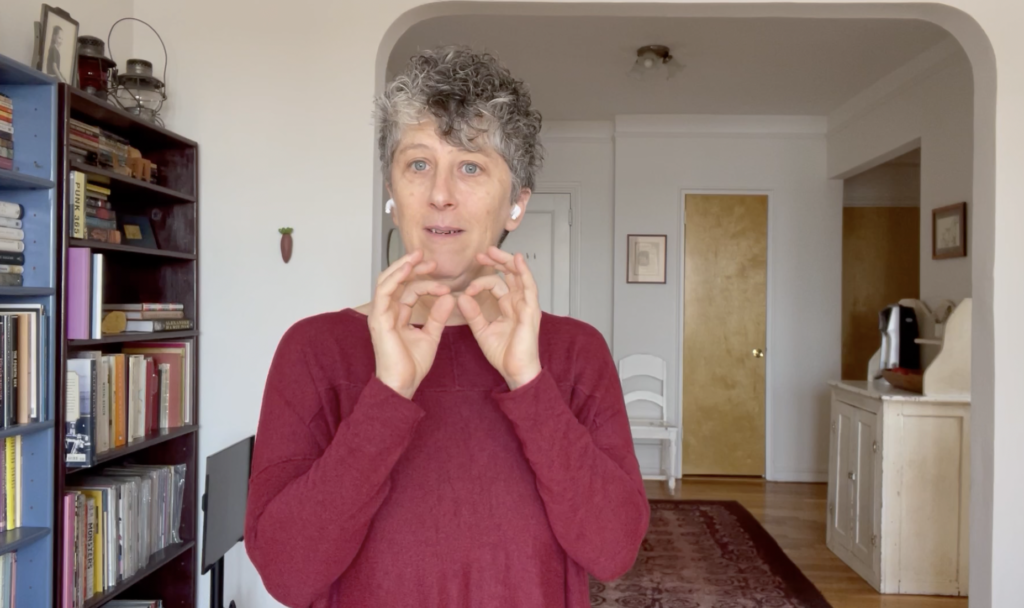VOCAL FRY IS NO FUN BUT THERE IS A SOLUTION
Do you sometimes feel tight in your throat? Do you wonder why your voice is small and tight on some days, easy and resonant on others? There may be many causes for this, but the one I’m going to talk about today is called vocal fry, which is a kind of gritty sound that occurs at the bottom of your vocal register. It can feel like the back of your tongue can’t quite find the right place to be when you speak. Your voice comes out creaky.
Many of my students are teachers and therapists who suffer from vocal fry or fatigue. They may be annoyed or even worried about it, but their training probably didn’t include any self-care techniques for the throat and voice. Like me for the last 15 years, they just ignore it and go on with their lives. But then, we all went online because COVID, and started watching recordings of ourselves and realized we wanted to do something about it!
Vocal fry is to a certain extent natural, and it’s not the worst vocal problem you could have, but it can feel crappy, lead to bigger problems over time, and make you sound strained or anxious. Likewise, if you have some simple tools to relieve vocal fry, your voice can feel so lovely and resonant. Who wouldn’t want that? It also puts your students and clients at ease.
TRY THESE THREE TIPS FOR A MORE RESONANT AND LESS RASPY VOICE
Here are 3 tips, based on my Cranial Nerve Sequencing practices, to help with vocal fry. You will learn how to ease your tongue, throat and voice simply through understanding the basic functions of the “glossopharyngeal” or 9th nerve. These functions include sensation at the back of your tongue, motor control for swallowing, and parasympathetic functioning of your salivary glands, blood pressure, and breathing.
I’ve been using these 3 tips with my students and we are all experiencing benefits! Watch the video and follow along, or read below and explore on your own:
ONE:
FEEL: Enjoy the sensations you feel from the back of your tongue. What is it touching and feeling?
TWO:
MOVE: Gently explore the different ways the back of your tongue can move inside your mouth. Start small. Use the back of your tongue, leaving the tip quiet. Can you feel your soft palette, the hard roof or your mouth, the back of your throat, the skin around your teeth, the back of your upper and lower molars? If you are using neck, shoulder, or back muscle to move your tongue, you are working too hard. Make smaller movements. Let your jaw be mobile and try with lips both closed and open.
THREE:
SHIFT BALANCE: Look slightly down and let the weight of your head tip gently forward. How does your tongue respond? Are you sensing any movement there? If it doesn’t move, chances are you are holding your tongue in place when you don’t need to. Experiment with small side to side shifts of balance also. Holding your tongue in place will interfere with balance and make your neck tight.
AN EASY TONGUE AND THROAT HAVE SURPRISING SIDE EFFECTS
Attending to sensation at the back of the tongue is the easiest way to connect with cranial nerve 9. Likewise, when I’m aware of the sensations it’s experiencing, my tongue becomes easy and independent of my head and jaw. I am more able to move my tongue freely inside my mouth, and this freedom in turn opens and eases my throat.
Here is what glosspharyngeal nerve looks like (there are other nerves in this image that it connects to in complex ways, but you can see it labeled, third from the top):

You can see how many small, delicate muscles there are in this part of your body! The 9th cranial nerve has multiple kinds of fibers. It has sensory, motor, and parasympathetic neurons. Translated into english, that means It carries out sensory, voluntary, and involuntary activity in your body:
- Motor control of stylopharyngeus muscle for swallowing
- Sensation and taste from the back two thirds of the tongue
- Sensation from the inner ear (where the tiny hammer, anvil, and stirrup bones reside)
- Parasympathetic activation of lymphatic tissue of the tonsils on left and right sides of the back of your through (immune response) and the parotid gland (saliva production)
- Parasympathetic sensations from the carotid artery (regulation of blood pressure and blood gasses carbon & oxygen)
Who even knew that you could feel anything in your inner ear? To be fair, parasympathetic functions are below your level of consciousness, but I find it intriguing just to know that my heart rate and breathing are neighbors to my tongue. The relationships between these things may be indirect, but they are there.
To find out more about how Cranial Nerve Sequencing can help you unlock hidden potential in your body, mind, and spirit, here are three options:
Attend this upcoming workshop.
Watch a recording of the preceding workshop.
Book a free 15 minute consult to see if a 12 lesson program is right for you.

